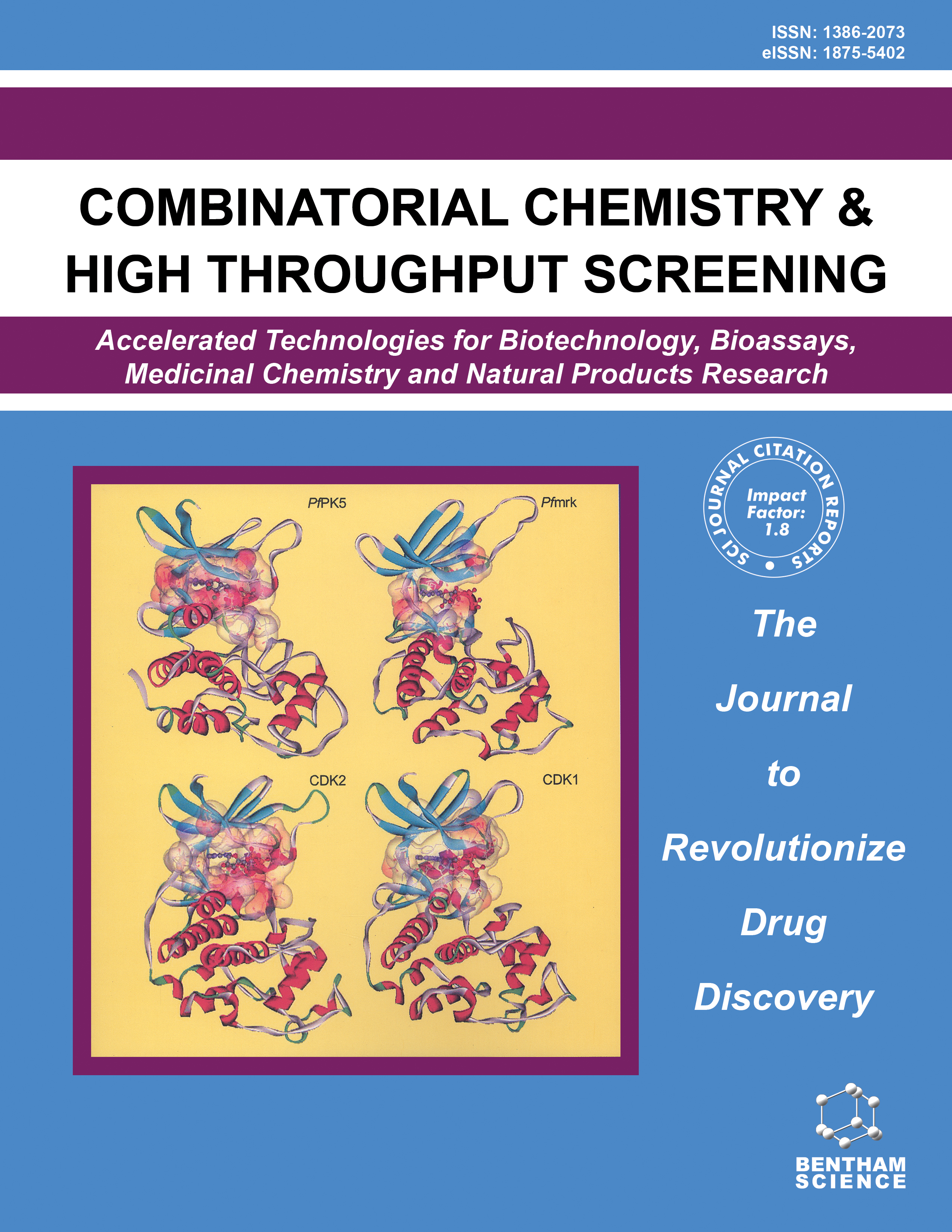- Home
- A-Z Publications
- Combinatorial Chemistry & High Throughput Screening
- Previous Issues
- Volume 4, Issue 7, 2001
Combinatorial Chemistry & High Throughput Screening - Volume 4, Issue 7, 2001
Volume 4, Issue 7, 2001
-
-
Identification of Enzyme Inhibitors from Phage-Displayed Combinatorial Peptide Libraries
More LessAuthors: B.K. Kay and P.T. HamiltonIn recent years, there have been a growing number of examples of the successful isolation of peptide ligands for enzymes from phage-displayed combinatorial peptide libraries. These peptides typically bind at or near the active site of the enzymes and can inhibit their activity. We review the literature on peptide ligands that have been isolated for enzymes other than proteases as well as present data on peptide ligands we ha Read More
-
-
-
Identification of a Novel Human Peroxisomal 2,4-Dienoyl-CoA Reductase Related Protein Using the M13 Phage Protein VI Phage Display Technology
More LessAuthors: L. Amery, G.P. Mannaerts, S. Subramani, P.P. van Veldhoven and M. FransenRecently, we reported the successful use of the gVI-cDNA phage display technology to clone cDNAs coding for novel peroxisomal enzymes by affinity selection using immobilized antisera directed against peroxisomal subfractions (Fransen, M. Van Veldhoven, P.P. Subramani, S. Biochem. J., 1999, 340, 561-568). To identify other unknown peroxisomal enzymes, we further exploited this promising approach. Here we report the Read More
-
-
-
Identification of Small Molecule Binding Sites within Proteins Using Phage Display Technology
More LessAuthors: D.J. Rodi, G.E. Agoston, R. Manon, R. Lapcevich, S.J. Green and L. MakowskiAffinity selection of peptides displayed on phage particles was used as the basis for mapping molecular contacts between small molecule ligands and their protein targets. Analysis of the crystal structures of complexes between proteins and small molecule ligands revealed that virtually all ligands of molecular weight 300 Da or greater have a continuous binding epitope of 5 residues or more. This observation led to the deve Read More
-
-
-
Substrate Phage as a Tool to Identify Novel Substrate Sequences of Proteases
More LessAuthors: S. Ohkubo, K. Miyadera, Y. Sugimoto, K-i. Matsuo, K. Wierzba and Y. YamadaCombinatorial phage peptide libraries have been used to identify the ligands for specific target molecules. These libraries are also useful for identification of the specific substrates of various proteases. A “substrate phage library” has a random peptide sequence at the N-terminus of the phage coat protein and an additional tag sequence that enables attachment of the phage to an immobile phase. When these libraries ar Read More
-
-
-
Predicting In Vivo Protein-Peptide Interactions with Random Phage Display
More LessAuthors: J.F. Smothers and S. HenikoffBinding sites in protein complexes occasionally map to small peptides within one or more proteins. Random peptide display methods simulate binding interactions by providing all possible peptide combinations with an equal opportunity to bind a protein of interest. The natural substrates for the protein are typically known in advance. However, it is often the case that such substrates are identified as putative partner proteins Read More
-
-
-
The Cloning of Human Genes Using cDNA Phage Display and Small-Molecule Chemical Probes
More LessAuthors: S.N. Savinov and D.J. AustinThe cloning of genes based on protein function has become a powerful tool for protein discovery and should play an important role in proteomics in general. We have recently reported a technique for the functional identification of protein targets by combining traditional affinity chromatography with cDNA phage display. This procedure, referred to as display cloning, directly couples biologically active natural products to the gene Read More
-
-
-
Caveat Receptor: Proteomes on Display
More LessBy F.J. StevensDisplay methods development is currently extending the application of this strategy beyond the generation of ligand binding reagents for research, clinical, or biotechnological purposes to its use as a primary research tool. Peptide- and cDNA display methods have the potential to contribute to understanding the mechanisms of certain classes of drugs and to help map protein-protein interactions of physiological importance. Alth Read More
-
Volumes & issues
-
Volume 28 (2025)
-
Volume 27 (2024)
-
Volume 26 (2023)
-
Volume 25 (2022)
-
Volume 24 (2021)
-
Volume 23 (2020)
-
Volume 22 (2019)
-
Volume 21 (2018)
-
Volume 20 (2017)
-
Volume 19 (2016)
-
Volume 18 (2015)
-
Volume 17 (2014)
-
Volume 16 (2013)
-
Volume 15 (2012)
-
Volume 14 (2011)
-
Volume 13 (2010)
-
Volume 12 (2009)
-
Volume 11 (2008)
-
Volume 10 (2007)
-
Volume 9 (2006)
-
Volume 8 (2005)
-
Volume 7 (2004)
-
Volume 6 (2003)
-
Volume 5 (2002)
-
Volume 4 (2001)
-
Volume 3 (2000)
Most Read This Month
Article
content/journals/cchts
Journal
10
5
false
en

Most Cited Most Cited RSS feed
-
-
Label-Free Detection of Biomolecular Interactions Using BioLayer Interferometry for Kinetic Characterization
Authors: Joy Concepcion, Krista Witte, Charles Wartchow, Sae Choo, Danfeng Yao, Henrik Persson, Jing Wei, Pu Li, Bettina Heidecker, Weilei Ma, Ram Varma, Lian-She Zhao, Donald Perillat, Greg Carricato, Michael Recknor, Kevin Du, Huddee Ho, Tim Ellis, Juan Gamez, Michael Howes, Janette Phi-Wilson, Scott Lockard, Robert Zuk and Hong Tan
-
-
- More Less

